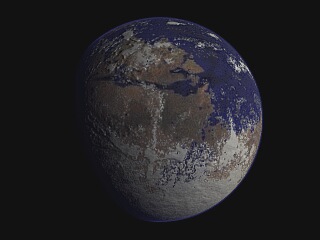
Refinements to the planetary images
Extra elements may be added into the POV-Ray scene to produce a more elaborate and more realistic atmosphere. The following four images were generated using a POV-Ray scene file based on one developed by Constantine Thomas. The extra goodies are specular reflection from water surfaces and variable-transparency clouds based on a cloud map of the Earth. I have changed the atmospheric haze code slightly, and added some small-scale variation to the cloud bump-map, and used land- and sea-maps based on the image map used for the previous three views- alas, this means that the specular reflection layer does not work on the first four images shown below...

Mars 1: view from south of the equator. The south pole is under the extensive cloud cover at the bottom of the planet; Valles Marineris is just above the centre of the disc.

Mars 2: view from well north of the equator, after the northern mid-winter. An ice cap has developed over the north pole, and Elysium Mons is visible just below the centre of the disc. The northern limits of Hesperia Planum appear near the lower limb of the planet.
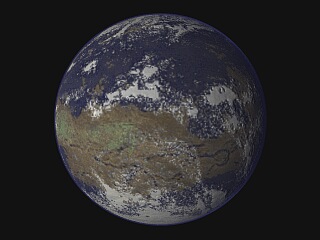
Venus 1: from above the equator. Aphrodite Terra is visible.
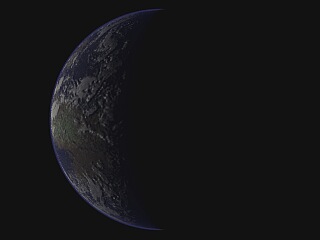
Venus 2: a crescent view.
Whilst these views are not unappealing, they can be improved. Higher-resolution bump, image and cloud maps may be used, and specular reflection from water may be added. It is possible to wrap a height field (employing the same image as used for a bump map) around a sphere (using Gilles Tran's method for doing so in POV-Ray 3.5) and to project the planetary image map onto that, and to combine the resulting surface with an "ocean" sphere having specular reflection properties. The ocean sphere can have an image map made from tinting the height field image with an ocean colour, in order to represent different depths of water. Media code can then be added to simulate the atmosphere, and a cloud map to give cloud cover.
This will then give a truly three-dimensional planet surface, with reflective water. An alternative is to use an image map, a land-area-only bump map, a specular mask to delineate water/land areas, a cloud map and atmosphere code, using multiple image-mapped spheres with specific transparencies to render the planet. It may be a minor point, but the bump map will give only the appearance of elevation- the planet surface will still actually be a perfectly smooth sphere.
Below are shown various views rendered using Gilles Tran's code, modified for this particular context. Medium- to high-resolution maps have been used, from various sites, including NASA's Blue Marble site, and from www.space-graphics.com.
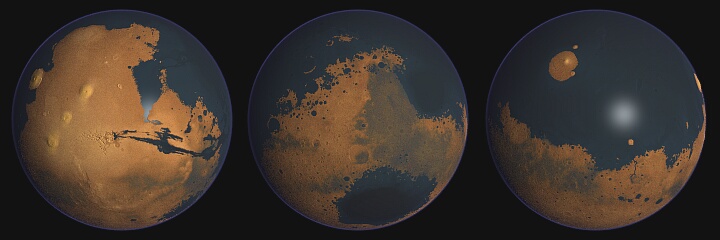
Mars: essentially the same views as on the first terraforming page. No cloud layer, but specular water reflections, atmospheric haze, and a "translucent" water layer to reveal depth variations.
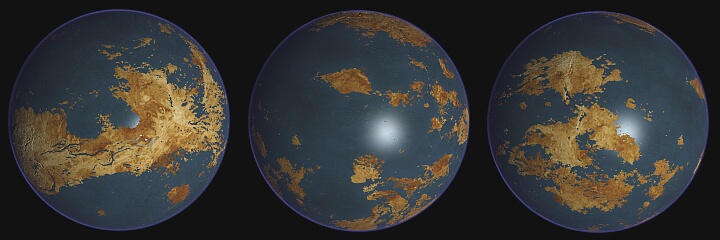
Venus: as before. The land image map is, I think, actually based on Magellan radar reflectivity data, so it does not actually represent the true pigmentation of the surface- whatever that may turn out to be...
Views of Mars (left, 102k) and Venus (right, 64k), including cloud maps. On Mars, Valles Marineris is just above and right of centre; the view is from south of the equator. The image map for Mars has been modified as follows: the height-field image was inverted (i.e. made negative) tinted with green, and then merged with the "standard" image map. This gives low-lying areas a hint of green...In the crescent view of Venus, reflection of sunlight is seen from lakes in the Artemis Chasma region of Aphrodite Terra.
The cloud maps used are ones derived from images from Earth-orbiting satellites. That is, the distribution of the clouds is relevant to the topography and atmospheric dynamics of Earth- not of Mars or Venus. Applying these cloud maps to Mars and Venus, as it were, is an approximation. One might edit the cloud maps in order to reflect, to some degree, the topography of a wet Mars or Venus, but the possible atmospheric circulation patterns that would apply in each case are another matter again.
Mars poster
The "thumbnail" below is a link to a fairly hefty (665kb) mosaic image of various prominent or interesting features on Mars.